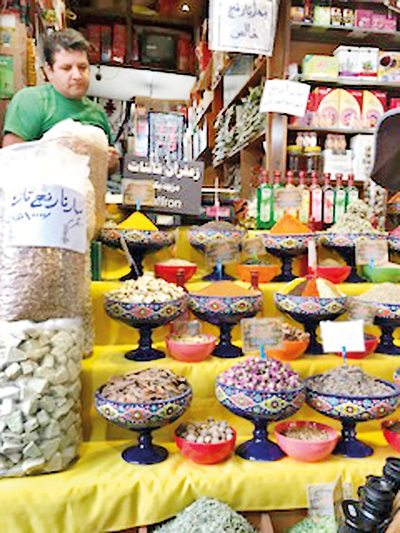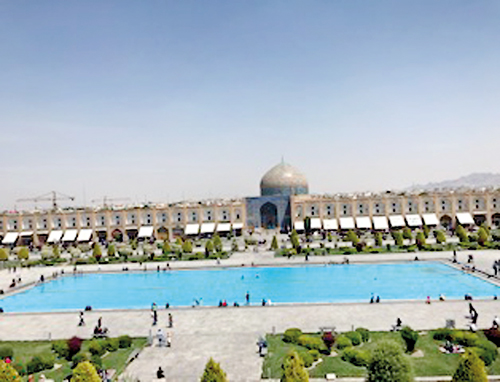From one ancient city to another, each with their own stories to tell

A colourful bazaar
The group drove from Yazd to Shiraz via Pasargadae, a journey of six hours. We stopped at Abarkuh to see a Cypress tree over 4,000 years old and an Icehouse (created for refrigeration purposes).The earliest Icehouse (yakschals) dates back to 400 BC. Water was tapped from the mountains via the ancient qanat system into deep pools. Once the water froze it was transported to the conical mud brick icehouse. A spiral water system built into the walls kept the structure cool.
The Achaemendis began their domination from the 9th century BC and ruled the largest empire in the world (South West Persia, Mesopotamia, from Greece to the Indus Valley). Pasargadae, the capital was founded by Cyrus the Great. Cyrus respected the customs and religions of the countries he conquered and was recognised for his human rights, politics, and military strategies. He played a crucial role in defining the modern role of Iran. I visited the limestone tomb perched on a height near the ruins of his palace.
His epitaph states:
“Man, whoever you are and wherever you come from, for I know you will come, I am Cyrus who won the Persians their empire. Do not therefore begrudge me this bit of earth that covers my bones.”
It has been said that Alexander of Macedonia (the term the ‘Great’ is not used by Iranians) paid homage at his tomb and on his return from his travels when he entered the tomb found Cyrus’s body had disappeared. Historians rank Cyrus above Alexander, who destroyed the Empire but failed to provide an alternative.
Not far off are the remains of three palaces belonging to the Achaemendians – the Entrance, Audience and Cyrus’s private palace. There are some pillars, foundations, gateways, and stone reliefs.
Shiraz, the garden city in the Fars Province was our base for three nights. The city is recognised for its “culture” and was formerly a wine growing district. It has a pleasant climate and its universities are renowned. The tourist industry is popular and the guides extremely helpful and knowledgeable but service at the hotels can be slightly lacking due to insufficient training.
The ‘cherry on the cake’ was our visit to Nagsh-e-Rostam, an hour’s drive away and the afternoon was spent in Persepolis. The rock tombs, and reliefs at Naqsh I Rajab were of the Achaemendian kings. This was the celebratory site of the festival of ‘Nowruz’ celebrated in the country on March 21 heralding spring. The carvings are well preserved and there are representations of a Roman Emperor to a Sasanian King.

Isfahan: An ancient capital of the country and the second largest city
Darius the Great was another important ruler from the same dynasty, who established Persepolis and received foreign delegations at his ornate palace. Some of the Royal tombs are carved into the mountain and it is a steep climb. The Shah, to celebrate 2,500 years of the Persian Empire in 1971, feted world leaders at an extravagant ceremony held on the site at massive expense. The publicity was adverse and eventually led to his downfall years later.
The entrance to the palace is through the double stone Terrace Stairway. Each flight has 111 steps with crenellated parapets indicating the terrace as a citadel from the exterior. In the premises, are inscriptions carved on doorjambs by Xerxes leading to a hall named “The Gate of All Lands”. A stone bench on the interior indicates where the Royal guests waited for their audience. The western and eastern doorways have sculptures of “guardian figures” with a bullock’s body, wings of an eagle and a crowned head of a bearded man. The two Eagle Griffin (Homa), an auspicious bird mounted on a short pillar which was rejected or unused is nearby.
Imposing with its stone reliefs is the One Hundred Column Hall, the largest chamber built by Xerxes and completed by his son. This was the King’s audience hall. The columns supported a black stone ceiling and the entrance to the north portico is sculptured.
The “Audience Relief” made of a huge slab of stone is one of two discovered and then placed at the top of a stairway. The superior relief is in the Teheran museum.The relief on site indicates Xerxes enthroned. On the South wing of the Eastern stairway are three registers of sculpted figures of the delegations visiting during the spring festival. These delegations paid tribute of their own free will.Their robes indicate the identity of the representatives.

World Square at Isfahan
At the back of the complex are the foundations of an immense treasury built by Darius the Great and enlarged by Xerxes. It had thick walls and an entrance. It was reported that Alexander used 3,000 camels and mules to carry off the loot. However, fragments of vessels, statues and stone tablets have been discovered. Alexander destroyed Persepolis and later felt remorse.
Tucked away off a side street in Shiraz is the 19th century Pink Mosque,known as Nasir–ul-Mulk built during the Qajar period. The striking features are the predominant pink tiles. The mosque has short minarets and its myriad stained glass windows and arches within the winter prayer hall are breathtaking especially with the sun filtering through in the early morning.
Visits were made to the memorial gardens of two of Iran’s greatest poets and to Sufi shrines. Driving towards Isfahan, we explored a secluded castle at Izadkhast.
Isfahan, an ancient capital of the country and the second largest city was our final destination. There were visits to the Friday Mosque, the Bazaar, and the Ali Qapu Palace set in the grandest square (‘Pattern of the World’). Ali Qapu was the former residence of the Royal family and opposite is the Shah Mosque with traditional Islamic architecture.
The Armenian quarter in the city houses the Cathedral and the church of St. Bethlehem. The Armenians were invited to live in Persia by Shah Abbas II who was a progressive ruler.
Our trip was made “special” by the expert lecturer, and guide who introduced us to the traditions of the country, the history, an introduction to Islam and the legends of the Book of Kings, the “Shahnameh” written by Ferdowsi, an Iranian Poet.
| Little tips when visiting Iran | |
| It is worth bearing in mind that female visitors should wear a hijab and modest garments. Cash is required and in rare instances credit cards accepted. The local currency is rials. Thursday and Friday is the weekend. No alcohol is sold openly. The food is mainly meat based with kebabs, stews, Dizi (slow cooked lamb with chickpeas in a soup), rice with barberries, meats cooked with plums, quince, apricots, pomegranates and nuts, fried fish, yoghurt and different breads. The people are friendly, cultured, and refined. There were numerous instances when the group were warmly welcomed and requests made for photos together. I felt secure (not having touts or beggars hanging on). It was an enchanting and unforgettable experience travelling the ancient “Silk Route”. |


